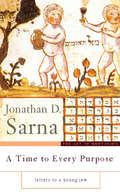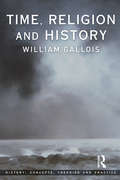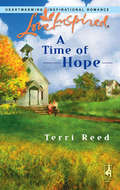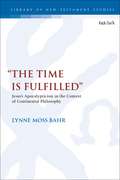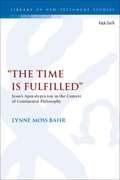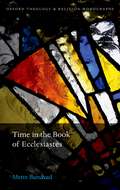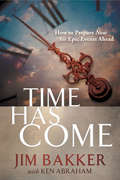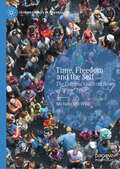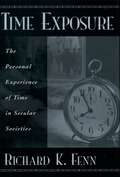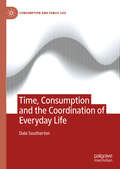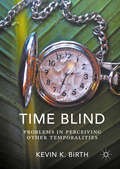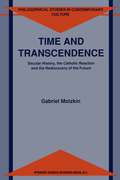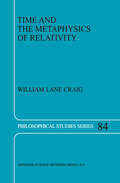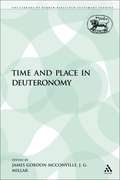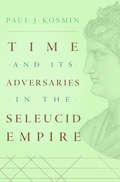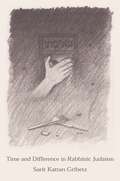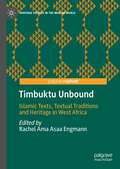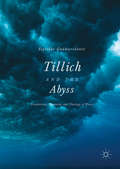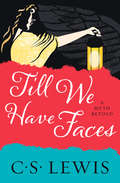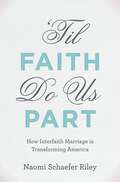- Table View
- List View
A Time to Every Purpose: Letters to a Young Jew
by Jonathan D SarnaAt the turn of the twenty-first century, the central question confronting Jewish leaders in America is simple: Why be Jewish?Jonathan D. Sarna, acclaimed scholar of American Judaism, believes that "Why be Jewish?” is the wrong question. Judaism, he believes, is not so much a "why” as a way-a way of life, a way of marking time, a way of relating to the environment, to human beings, to family, and to God. Judaism is experienced through doing-doing things Jewish, doing things for fellow Jews in need, doing things as a Jew to improve the state of the world. The more Judaism one does, the more one comes to appreciate what Judaism is. Using the Jewish calendar as his starting point, Sarna reflects on the major themes of Jewish life as expressed in a full year of holidays-from Passover in the spring to Purim eleven months later. Passover, for instance, yields a discussion of freedom; Shavuot, a discussion of Torah; Yom Kippur, the role of the individual within the Jewish community; Chanukah, issues of assimilation and anti-assimilation. An essential brief introduction-or reintroduction-to the major practices of Jewish life as well as the many complexities of the American Jewish experience, this book will be essential reading for American Jews and the perfect gift for the holiday season.
Time, Religion and History
by William GalloisWhat is time? How does our sense of time lead us to approach the world? How did the peoples of the past view time? This book answers these questions through an investigation of the cultures of time in Christianity, Islam, Buddhism, Judaism and the Australian Dreamtime. It argues that our contemporary world is blind as to the significance and complexity of time, preferring to believe that time is 'natural' and unchanging. This is of critical importance to historians since the base matter of their study is time, yet there is almost no theoretical literature on time in history.This book offers the first detailed historiographical study of the centrality of time to human cultures. It sets out the complex ways in which ideas of time developed in the major world religions, and the manner in which such conceptions led people both to live in ways very different to our contemporary world and to make very different kinds of 'histories'. It goes on to argue that modern scientific descriptions of time, such as Einstein's Theory of Relativity, lie much closer to the complex understandings of time in religions such as Christianity than they do to our 'common-sense' notions of time which are centred on progress through a past, present and future.
Time, Religion and History
by William GalloisWhat is time? How does our sense of time lead us to approach the world? How did the peoples of the past view time? This book answers these questions through an investigation of the cultures of time in Christianity, Islam, Buddhism, Judaism and the Australian Dreamtime. It argues that our contemporary world is blind as to the significance and complexity of time, preferring to believe that time is 'natural' and unchanging. This is of critical importance to historians since the base matter of their study is time, yet there is almost no theoretical literature on time in history.This book offers the first detailed historiographical study of the centrality of time to human cultures. It sets out the complex ways in which ideas of time developed in the major world religions, and the manner in which such conceptions led people both to live in ways very different to our contemporary world and to make very different kinds of 'histories'. It goes on to argue that modern scientific descriptions of time, such as Einstein's Theory of Relativity, lie much closer to the complex understandings of time in religions such as Christianity than they do to our 'common-sense' notions of time which are centred on progress through a past, present and future.
A Time of Hope (Mills And Boon Love Inspired Ser.)
by Terri ReedThe new temporary pastor of Hope Community Church was everything Mara Zimmer was trying to avoid. Jacob Durand was young, good-looking and interested. She was terrified that if he learned about her tragic past, he'd turn his back on her, too. Jacob didn't know what Mara was hiding, only that somehow she'd managed to steal his heart.
“The Time Is Fulfilled”: Jesus’s Apocalypticism in the Context of Continental Philosophy (The Library of New Testament Studies)
by Lynne Moss BahrIn this study, Lynne Moss Bahr explores the concept of temporality as central to Jesus's proclamation of the Kingdom of God. Using insights from continental philosophy on the messianic, which expose the false claim that time progresses in a linear continuum, Bahr presents these philosophical positions in critical dialogue with the sayings of Jesus regarding time and time's fulfillment. She shows how the Kingdom represents the possibilities of a disruption in time, one that reveals the intrinsic relation between God and humanity. In illustrating how Jesus's sayings regarding time are thus expressions of his messianic identity-as of the world and not of the world--Bahr argues that the meaning of Jesus's identity as Messiah is embedded in the disjuncture of time, in the impossibility of "now," from which the Kingdom comes . Bahr's use of critical theory in this study expands the concept of God's Kingdom beyond the traditional confines of the discipline.
“The Time Is Fulfilled”: Jesus’s Apocalypticism in the Context of Continental Philosophy (The Library of New Testament Studies)
by Lynne Moss BahrIn this study, Lynne Moss Bahr explores the concept of temporality as central to Jesus's proclamation of the Kingdom of God. Using insights from continental philosophy on the messianic, which expose the false claim that time progresses in a linear continuum, Bahr presents these philosophical positions in critical dialogue with the sayings of Jesus regarding time and time's fulfillment. She shows how the Kingdom represents the possibilities of a disruption in time, one that reveals the intrinsic relation between God and humanity. In illustrating how Jesus's sayings regarding time are thus expressions of his messianic identity-as of the world and not of the world--Bahr argues that the meaning of Jesus's identity as Messiah is embedded in the disjuncture of time, in the impossibility of "now," from which the Kingdom comes . Bahr's use of critical theory in this study expands the concept of God's Kingdom beyond the traditional confines of the discipline.
Time in the Book of Ecclesiastes (Oxford Theology and Religion Monographs)
by Mette BundvadTime in the Book of Ecclesiastes offers a detailed analysis of the theme of time in Ecclesiastes. The book of Ecclesiastes engages at length with this theme and presents a sophisticated exploration of humanity's temporal situation. Ecclesiastes depicts the temporal reality as extremely problematic for human attempts to live meaningfully. This is especially due to the tension which the book's narrator perceives between the cosmic, temporal reality and the human experience of time. Consequently, humanity's cognitive engagement with time becomes a particular focus in his exploration of life under the sun. Time is not only a central theme in Ecclesiastes; it is also a theme which provides this difficult book with a degree of coherence and renders meaningful some of the passages which otherwise seem contradictory. Furthermore, the explicit exploration in Ecclesiastes of the theme of time provides an excellent entry-point into the broader discussion regarding the presence and character of temporal thinking in the Hebrew Bible more generally. Mirroring the interest in Ecclesiastes for both, Dr Mette Bundvad discusses the biblical book's presentation of both the cosmic temporal structures and the framework of the human past, present and future. It offers close readings of a series of passages in which the theme of time is especially prominent, thus demonstrating how the discussion of time works in Ecclesiastes and how it interacts with other of the book's key-themes.
Time Has Come: How to Prepare Now for Epic Events Ahead
by Jim BakkerA prophetic drama that is a brilliant new take on the book of Revelation. Gives readers fresh insight, peace of mind,and a great hope for the future.
Time, Freedom and the Self: The Cultural Construction of “Free” Time (Leisure Studies in a Global Era)
by Michelle Shir-WiseWhile abundant research has investigated time use, much less attention has been given to the cultural meanings attached to free time and what these may express with regard to conceptions of freedom and the self. In an attempt to fill this gap, Michelle Shir-Wise examines not only what people do in their free time, but also how they perceive, interpret and experience it, and in what way it relates to notions of happiness, freedom and the ideal self. Time, Freedom and the Self draws on contemporary theoretical debates concerning the relation between discourse, cultural repertoires, subjective meaning and agency, as well as literature around the sociology of leisure, to inform a unique interpretation of free time (“disciplined freedom”), developed in the light of questionnaires and in-depth interviews with middle-class, middle-aged participants in suburban Israel.
Time Exposure: The Personal Experience of Time in Secular Societies
by Richard K. FennIn his new book, Richard Fenn looks at the way in which we experience time in a secular society. He argues that secularization is virtually synonymous with individualism. Fenn shows that the Church created the idea of individualism through its demysitification of the universe, its insistence on individual self-discipline, and its intensification of individual responsibility for the use of time. Required to take responsibility for his or her own standing in the eyes of God, the individual emerged from the protection of the Church into the full current of time. No longer protected by Providence or connected to Eternity, our lives have become radically temporal and contingent. Fenn explores the modern experience of time, as expressed in such phrases as "wasting time" and "making up for lost time." In particular, he is interested in the idea of waiting, which he believes is a defining characteristic of modern life. He also argues that the secularization of time produced anxiety about death, and shows the various strategies we have created for dealing with this anxiety. Beautifully written and thoughtfully argued, this volume raises the secularization debate to a new level of depth and sophistication.
Time, Consumption and the Coordination of Everyday Life (Consumption and Public Life)
by Dale SouthertonTime pressure, speed and the desire for instant consumption pervade accounts of contemporary lives. Why is it that people feel pressed for time, in what ways have societies changed to create this condition, and with what implications? This book examines critical contentions in the field of time and society, ranging from the emergence and dominance of ‘clock time’ and time discipline, the time pressures associated with consumer culture, through to technological innovation and the acceleration of everyday lives. Through extensive analysis of empirical studies of the changing ways in which people organise and experience home, work, leisure, consumption and personal relationships, time pressure is shown to be a problem of the coordination and synchronization of activities. Appreciation of temporal rhythms – formed and reproduced through the organisation and performance of social practices – is necessary to tackle the challenges of coordination, and offers new avenues for analysing social issues such as sustainable consumption, health and well-being. This book is essential reading for all of those interested in social change, consumption and time, including researchers and students from across the social sciences.
Time Blind: Problems in Perceiving Other Temporalities
by Kevin K. BirthThis book explores how modern concepts of time constrain our understanding of temporal diversity. Time is a necessary and pervasive dimension of scholarship, yet rarely have the cultural assumptions about time been explored. This book looks at how anthropology--a discipline known for the study of cultural, linguistic, historical, and biological variation and differences--is blind to temporalities outside of the logics of European-derived ideas about time. While the argument focuses primarily on anthropology, its points can be applied to other fields in the sciences, humanities, and social sciences.
Time Blind: Problems in Perceiving Other Temporalities
by Kevin K. BirthThis book explores how modern concepts of time constrain our understanding of temporal diversity. Time is a necessary and pervasive dimension of scholarship, yet rarely have the cultural assumptions about time been explored. This book looks at how anthropology--a discipline known for the study of cultural, linguistic, historical, and biological variation and differences--is blind to temporalities outside of the logics of European-derived ideas about time. While the argument focuses primarily on anthropology, its points can be applied to other fields in the sciences, humanities, and social sciences.
Time and Transcendence: Secular History, the Catholic Reaction and the Rediscovery of the Future (Philosophical Studies in Contemporary Culture #1)
by G. MotzkinThis book investigates one aspect of the story of how our religiously-oriented culture became a secular one. It concentrates on the conflicts enveloping the attitude to the past from the late seventeenth to the early twentieth century. The background argument is that the way the process of secularization occurred in one particular religious context, the Roman Catholic one, was determinative for the possibility of something such as secular culture, and hence for both the modem secular attitude to the past and the modem religious one. In recent years a spate of scholarship has suggested that the expanded version of Weber's theory, according to which modernity is a consequence of Protestan tism, is not quite accurate. Robert Merton modified this theory to argue that modem natllral science originated in the context of seventeenth-century 1 Protestant England. Against this position, many scholars have investigated 2 origins for the development of science in Catholic countries. The development of natural science, however, is not the whole story of the development of modem secular culture, even if the story of that development is restricted to the development of knowledge. Our modem universities are organized around the division between humanities and natural sciences, and it can be thought that this process of modernization or secularization affected the humanities no less than the sciences.
Time and the Metaphysics of Relativity (Philosophical Studies Series #84)
by W.L. CraigThe larger project of which this volume forms part is an attempt to craft a coherent doctrine of divine eternity and God's relationship to time. Central to this project is the integration of the concerns of theology with the concept of time in relativity theory. This volume provides an accessible and philosophically informed examination of the concept of time in relativity, the ultimate aim being the achievement of a tenable theological synthesis.
Time and Process in Ancient Judaism (The Littman Library of Jewish Civilization)
by Sacha SternThis illuminating study is about the absence of a concept of time in ancient Judaism, and the predominance instead of process in the ancient Jewish world-view. Sacha Stern draws his evidence from the complete range of Jewish sources from this period: mainly early rabbinic literature, but also Jewish Hellenistic literature, Qumran sources, Apocrypha and Pseudepigrapha, and inscriptions. Following a methodological introduction drawing on anthropological studies, the author starts by focusing on the word used for time in early rabbinic literature, zeman. He shows that it means only ‘points in time’ or finite periods of time, but that the concept of time as a continuum—of time as a whole—is totally absent from rabbinic texts. It is unknown even in such obvious contexts as discussions of age, accounts of the creation of the universe, and in other matters relating to timing and time reckoning, the calendar, and chronology. He shows convincingly that although timing was central to early rabbinic halakhah, it was not conceived of as a measuring of the time dimension, but rather as a way of co-ordinating different processes (e.g. co-ordinating the reading of the Shema with sunrise or dusk). The calendar, likewise, was not a measurement of time but an astronomical scheme, and therefore only process-related. Similar conclusions apply to early rabbinic notions of chronology, history, and even ethics: the notion of time as an entity or a resource, so familiar in modern society, is completely unknown in rabbinic ethics. Further confirmation emerges from the author's study of non-rabbinic ancient Jewish sources in Greek, Hebrew and Aramaic, including Apocryphal and Pseudepigraphic works and Dead Sea Scrolls, sources that are also concerned with the calendar and chronology but without any notion of time per se. The absence of a concept of time is also attested in other Near eastern cultures, but stands in contrast to Graeco-Roman culture with its pervasive concept of chronos. The ancient Jewish view also stands in contrast with medieval Judaism, when the concept of time became well established in ethics, philosophy, biblical exegesis, and halakhah, a development which Stern attributes partly to the influence of Greek philosophy on medieval Jewish thinkers. He concludes with reflections on the wider implications of these findings, especially regarding the limited Hellenization of ancient Judaism and its cultural isolation within the Graeco-Roman world. This perceptive work, clearly, cogently, and convincingly argued, offers a new perspective on the world-view of ancient Judaism and its links with other cultures in the Near East of late antiquity.
Time and Place in Deuteronomy (The Library of Hebrew Bible/Old Testament Studies)
by James Gordon McConville J. G. MillarThe book is a literary and theological study of the themes of time and place, which aims to set the so-called 'centralization-law' of Deut 12-26 in the broad context of the book. The authors show that time and place are pervasive themes of Deuteronomy, a crucial part of its articulation of its understanding of history, religion and ethics. The heart of the thesis is that the foundational encounter between God and Israel at Horeb is paradigmatic for all subsequent encounters. For this reason, no one time or place can have final or absolute significance. The thesis thus calls into question the received view that the altar-law of Deut 12-26 is a 'centralization-law' associated with Josiah's reform. The refusal to identify the 'place' is no mere device against anachronism, but a consistent element in Deuteronomy's theology of history. The Connection between Deuteronomy and Josiah's reform has long been an important tenet of Old Testament criticism. The debate about the interpretation of Deuteronomy, however, has never been finally settled. The present study looks in a new way at the so-called 'centralization-law' of Deuteronomy which has been the most important factor in the traditional critical view of the book. It sets the law in the context of a broadly based study of the theology of the book, and comes to conclusions which call the connection with Josiah's reform into question. A broadly based study of the themes of time and place in Deuteronomy, calling into question accepted ideas about the purpose and setting of the book.
Time and Its Adversaries in the Seleucid Empire
by Paul J. KosminUnder Seleucid rule, time no longer restarted with each new monarch. Instead, progressively numbered years, identical to the system we use today, became the measure of historical duration. Paul Kosmin shows how this invention of a new kind of time—and resistance to it—transformed the way we organize our thoughts about the past, present, and future.
Time and Difference in Rabbinic Judaism
by Professor Sarit Kattan GribetzHow the rabbis of late antiquity used time to define the boundaries of Jewish identityThe rabbinic corpus begins with a question–“when?”—and is brimming with discussions about time and the relationship between people, God, and the hour. Time and Difference in Rabbinic Judaism explores the rhythms of time that animated the rabbinic world of late antiquity, revealing how rabbis conceptualized time as a way of constructing difference between themselves and imperial Rome, Jews and Christians, men and women, and human and divine.In each chapter, Sarit Kattan Gribetz explores a unique aspect of rabbinic discourse on time. She shows how the ancient rabbinic texts artfully subvert Roman imperialism by offering "rabbinic time" as an alternative to "Roman time." She examines rabbinic discourse about the Sabbath, demonstrating how the weekly day of rest marked "Jewish time" from "Christian time." Gribetz looks at gendered daily rituals, showing how rabbis created "men's time" and "women's time" by mandating certain rituals for men and others for women. She delves into rabbinic writings that reflect on how God spends time and how God's use of time relates to human beings, merging "divine time" with "human time." Finally, she traces the legacies of rabbinic constructions of time in the medieval and modern periods.Time and Difference in Rabbinic Judaism sheds new light on the central role that time played in the construction of Jewish identity, subjectivity, and theology during this transformative period in the history of Judaism.
Time and Difference in Rabbinic Judaism
by Professor Sarit Kattan GribetzHow the rabbis of late antiquity used time to define the boundaries of Jewish identityThe rabbinic corpus begins with a question–“when?”—and is brimming with discussions about time and the relationship between people, God, and the hour. Time and Difference in Rabbinic Judaism explores the rhythms of time that animated the rabbinic world of late antiquity, revealing how rabbis conceptualized time as a way of constructing difference between themselves and imperial Rome, Jews and Christians, men and women, and human and divine.In each chapter, Sarit Kattan Gribetz explores a unique aspect of rabbinic discourse on time. She shows how the ancient rabbinic texts artfully subvert Roman imperialism by offering "rabbinic time" as an alternative to "Roman time." She examines rabbinic discourse about the Sabbath, demonstrating how the weekly day of rest marked "Jewish time" from "Christian time." Gribetz looks at gendered daily rituals, showing how rabbis created "men's time" and "women's time" by mandating certain rituals for men and others for women. She delves into rabbinic writings that reflect on how God spends time and how God's use of time relates to human beings, merging "divine time" with "human time." Finally, she traces the legacies of rabbinic constructions of time in the medieval and modern periods.Time and Difference in Rabbinic Judaism sheds new light on the central role that time played in the construction of Jewish identity, subjectivity, and theology during this transformative period in the history of Judaism.
Timbuktu Unbound: Islamic Texts, Textual Traditions and Heritage in West Africa (Heritage Studies in the Muslim World)
by Rachel Ama Asaa EngmannTimbuktu Unbound: Islamic Texts, Textual Traditions and Heritage in West Africa is a cutting edge collection offering a reconsideration of manuscripts in Muslim West Africa. The contributors give voice to the dynamic ways in which textuality operates through technological innovations, ongoing habituated practices, and how the workings of power and authority within these communities inform these texts and their roles. To that end this book explores a number of interrelated themes: the social value of texts as objects; personal libraries as forms of investment/legacy; social practices involved in the exchange, movement and gifting of certain kinds of manuscripts; hierarchies and evaluative treatments of manuscripts, and quasi-market forces. The recent destruction and subsequent salvage operations to protect the Timbuktu manuscript libraries has highlighted their role as the quintessential exemplar of manuscript heritage in newly historicized Africa. Yet these events also underscore the prevalent narrative about Muslim West African cultural heritage - embodied in the form of manuscripts, archives and documents - as under dramatic and existential threat. This volume seeks to diverge from this dominant salvific starting point of heritage discourse - namely, that such objects are things of intrinsic value to be saved - in order to examine the more nuanced activities of diverse actors engaged in the study, preservation, acquisition, movement and, in some cases, destruction and disposal of the wide range of materials that constitutes the textual heritage of these societies.
Tillich and the Abyss: Foundations, Feminism, and Theology of Praxis
by Sigridur GudmarsdottirThis book examines Paul Tillich´s theological concept of the abyss by locating it within the context of current postmodern antifoundalist discussions and debates surrounding feminism, gender, and language. Sigridur Gudmarsdottir develops these tropes into a constructive theology, arguing that Tillich’s idea of the abyss can serve as a necessary means of deconstructing the binaries between the theoretical and the practical in producing nihilistic relativism and the safe foundations of knowledge (divine as well as human).How does one search for a map and method through an abyss? In his writings, Tillich expressed the ambiguity and groundlessness of being, the depth structure of the human condition, and the reality of God as an abyss. The more we gaze into this abyss, the more we encounter the faults in our various foundations. This book outlines how Tillich’s concept of the abyss creates greater opportunities for complexity and liminality and opens up a space where life and death, destruction and construction, fecundity and horror, womb and tomb, can coincide.
Till We Have Faces: A Myth Retold (G. K. Hall Perennial Bestsellers Ser.)
by C. LewisFascinated by the myth of Cupid and Psyche throughout his life, C. S. Lewis reimagines their story from the perspective of Psyche’s sister, Orual. ‘I saw well why the gods do not speak to us openly, nor let us answer . . . Why should they hear the babble that we think we mean? How can they meet us face to face till we have faces?’ Till We Have Faces is a brilliant examination of envy, betrayal, loss, blame, grief, guilt, and conversion. In this, his final – and most mature and masterful – novel, Lewis reminds us of our own fallibility and the role of a higher power in our lives.
'Til Faith Do Us Part: How Interfaith Marriage is Transforming America
by Naomi Schaefer RileyIn the last decade, 45% of all marriages in the U.S. were between people of different faiths. The rapidly growing number of mixed-faith families has become a source of hope, encouraging openness and tolerance among religious communities that historically have been insular and suspicious of other faiths. Yet as Naomi Schaefer Riley demonstrates in 'Til Faith Do Us Part, what is good for society as a whole often proves difficult for individual families: interfaith couples, Riley shows, are less happy than others and certain combinations of religions are more likely to lead to divorce. Drawing on in-depth interviews with married and once-married couples, clergy, counselors, sociologists, and others, Riley shows that many people enter into interfaith marriages without much consideration of the fundamental spiritual, doctrinal, and practical issues that divide them. Couples tend to marry in their twenties and thirties, a time when religion diminishes in importance, only to return to faith as they grow older and raise children, suffer the loss of a parent, or experience other major life challenges. Riley suggests that a devotion to diversity as well as to a romantic ideal blinds many interfaith couples to potential future problems. Even when they recognize deeply held differences, couples believe that love conquers all. As a result, they fail to ask the necessary questions about how they will reconcile their divergent worldviews-about raising children, celebrating holidays, interacting with extended families, and more. An obsession with tolerance at all costs, Riley argues, has made discussing the problems of interfaith marriage taboo. 'Til Faith Do Us Part is a fascinating exploration of the promise and peril of interfaith marriage today. It will be required reading not only for interfaith couples or anyone considering interfaith marriage, but for all those interested in learning more about this significant, yet understudied phenomenon and the impact it is having on America.
'Til Faith Do Us Part: How Interfaith Marriage is Transforming America
by Naomi Schaefer RileyIn the last decade, 45% of all marriages in the U.S. were between people of different faiths. The rapidly growing number of mixed-faith families has become a source of hope, encouraging openness and tolerance among religious communities that historically have been insular and suspicious of other faiths. Yet as Naomi Schaefer Riley demonstrates in 'Til Faith Do Us Part, what is good for society as a whole often proves difficult for individual families: interfaith couples, Riley shows, are less happy than others and certain combinations of religions are more likely to lead to divorce. Drawing on in-depth interviews with married and once-married couples, clergy, counselors, sociologists, and others, Riley shows that many people enter into interfaith marriages without much consideration of the fundamental spiritual, doctrinal, and practical issues that divide them. Couples tend to marry in their twenties and thirties, a time when religion diminishes in importance, only to return to faith as they grow older and raise children, suffer the loss of a parent, or experience other major life challenges. Riley suggests that a devotion to diversity as well as to a romantic ideal blinds many interfaith couples to potential future problems. Even when they recognize deeply held differences, couples believe that love conquers all. As a result, they fail to ask the necessary questions about how they will reconcile their divergent worldviews-about raising children, celebrating holidays, interacting with extended families, and more. An obsession with tolerance at all costs, Riley argues, has made discussing the problems of interfaith marriage taboo. 'Til Faith Do Us Part is a fascinating exploration of the promise and peril of interfaith marriage today. It will be required reading not only for interfaith couples or anyone considering interfaith marriage, but for all those interested in learning more about this significant, yet understudied phenomenon and the impact it is having on America.
